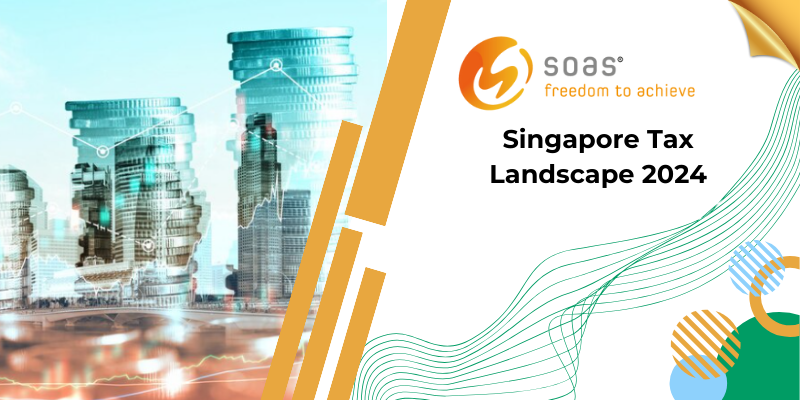New Horizons in Singapore Tax Landscape 2024

A transformative shift awaits Singapore as it braces for the imminent alteration in the Goods and Services Tax (GST) rate set to unfold in 2024. Embark on a journey through the intricacies of this impending change, illuminating the origins and repercussions of the upcoming GST rate adjustment that is poised to reshape the economic fabric in the coming year. Gain invaluable insights into how this evolution will not only impact businesses registered under GST but also extend its influence to individuals, providing essential guidance to traverse this economic transition seamlessly.
Singapore GST Transformation in 2024
In response to the dynamic economic landscape, the Singaporean government introduced a meticulously planned two-stage increase in the GST rate. The announcement came during Deputy Prime Minister (DPM) and Minister for Finance Lawrence Wong’s Budget Statement for the Financial Year 2022 in Parliament on February 18, 2022. Originally proposed in 2018 to elevate Singapore’s GST from 7% to 9% within the 2022 to 2025 timeframe, the plan faced unforeseen setbacks due to the challenges posed by the COVID-19 pandemic.
As a result, the GST rate adjustment unfolded in two phases:
- The initial increment, elevating the rate from 7% to 8%, became effective on January 1, 2023.
- The subsequent increase to 9% is scheduled to commence on January 1, 2024.
Refer to Lanturn’s Beginner’s Guide to Singapore’s GST for additional insights.
Navigating the Two-Stage GST Rate Change
The 2024 GST rate change in Singapore marks a significant fiscal milestone, characterized by a meticulously planned two-stage adjustment. Let’s delve into the specifics of each phase:
Phase 1: 2023 GST Rate Increase: Effective January 1, 2023, the first phase of the GST rate adjustment raised the rate from 7% to 8%. Consequently, purchases from GST-registered businesses in 2023 were subject to the new rate of 8%.
Phase 2: 2024 Upcoming GST Rate Increase: The second phase, slated for January 1, 2024, will witness the GST rate climbing from 8% to 9%. Purchases made on or after this date will be subject to the new rate of 9%. Special GST rules will apply to scenarios straddling the transition date, ensuring a fair application of the new rate.
Businesses are advised to proactively prepare for this transition, with the Inland Revenue Authority of Singapore (IRAS) issuing an e-tax guide tailored for GST-registered businesses.
GST Rate Change Implications and Impact
With the 2023 GST rate adjustment concluded and the 2024 increase on the horizon, it’s pivotal to comprehend the implications for both businesses and individuals in Singapore. Explore the tangible consequences of these changes and delve into the government’s initiatives aimed at facilitating a smoother transition.
Implications for Businesses:
- System Adjustments: Update systems to reflect the new 9% GST rate for compliance.
- Price Displays: Crucially update price displays to prevent confusion.
- Correct GST Charging: Ensure accurate charging to avoid penalties and disputes.
- Higher Costs: Anticipate potential operational cost increases and plan accordingly.
- Passing on Costs: Some businesses may pass increased costs to customers, affecting pricing and competitiveness.
Implications for Individuals:
- Higher GST Rate: Increased costs for goods and services, impacting the cost of living.
- Rising Prices: Higher GST may result in increased prices, affecting budgets.
- Marginal Personal Income Tax (PIT) Rate: Top PIT rate is set to rise from 22% to 24% in 2024.
- Safety Net for Lower-Income Households: Enhanced GST Voucher scheme and Assurance Package to alleviate the burden on lower-income households.
Final Thoughts
In summary, the impending shift in the Singapore tax landscape for 2024 signifies more than just a change in rates; it marks a transformative journey for businesses and individuals alike. The meticulously planned two-stage increase in the Goods and Services Tax (GST) is a response to the dynamic economic conditions, with the initial phase already underway and the second phase set to unfold in the coming year.
As businesses navigate the challenges of system adjustments, price displays, and potential cost implications, individuals are bracing for the impact on their cost of living, heightened by a rise in the GST rate and changes in the Personal Income Tax (PIT) rate.
However, amid these changes, the Singapore government has implemented measures such as the Assurance Package and the enhanced GST Voucher scheme to provide a safety net, particularly for lower-income households. Additionally, professional services like those offered by SOAS Accounting & Tax Services stand ready to guide businesses and individuals through this transition, ensuring a smooth and informed journey.
As Singaporeans prepare for this fiscal evolution, strategic planning, awareness of transitional rules, and leveraging available support will be key to not only adapting to the changes but thriving in the new tax landscape. With collaborative efforts from businesses, individuals, and expert services, the road ahead presents opportunities for growth and financial resilience in the ever-evolving fiscal terrain of Singapore.
FAQs: New Horizons in Singapore's Fiscal Landscape
Q: What is the upcoming change in Singapore's fiscal landscape?
A: Singapore is anticipating a transformative shift with the impending alteration in the Goods and Services Tax (GST) rate set to unfold in 2024.
Q: Why is the GST rate changing, and what are its origins?
A: The GST rate change originated from a meticulously planned two-stage increase introduced by the Singaporean government in response to the dynamic economic landscape.
Q: When was the initial phase of the GST rate adjustment implemented?
A: The first increment, elevating the GST rate from 7% to 8%, became effective on January 1, 2023.
